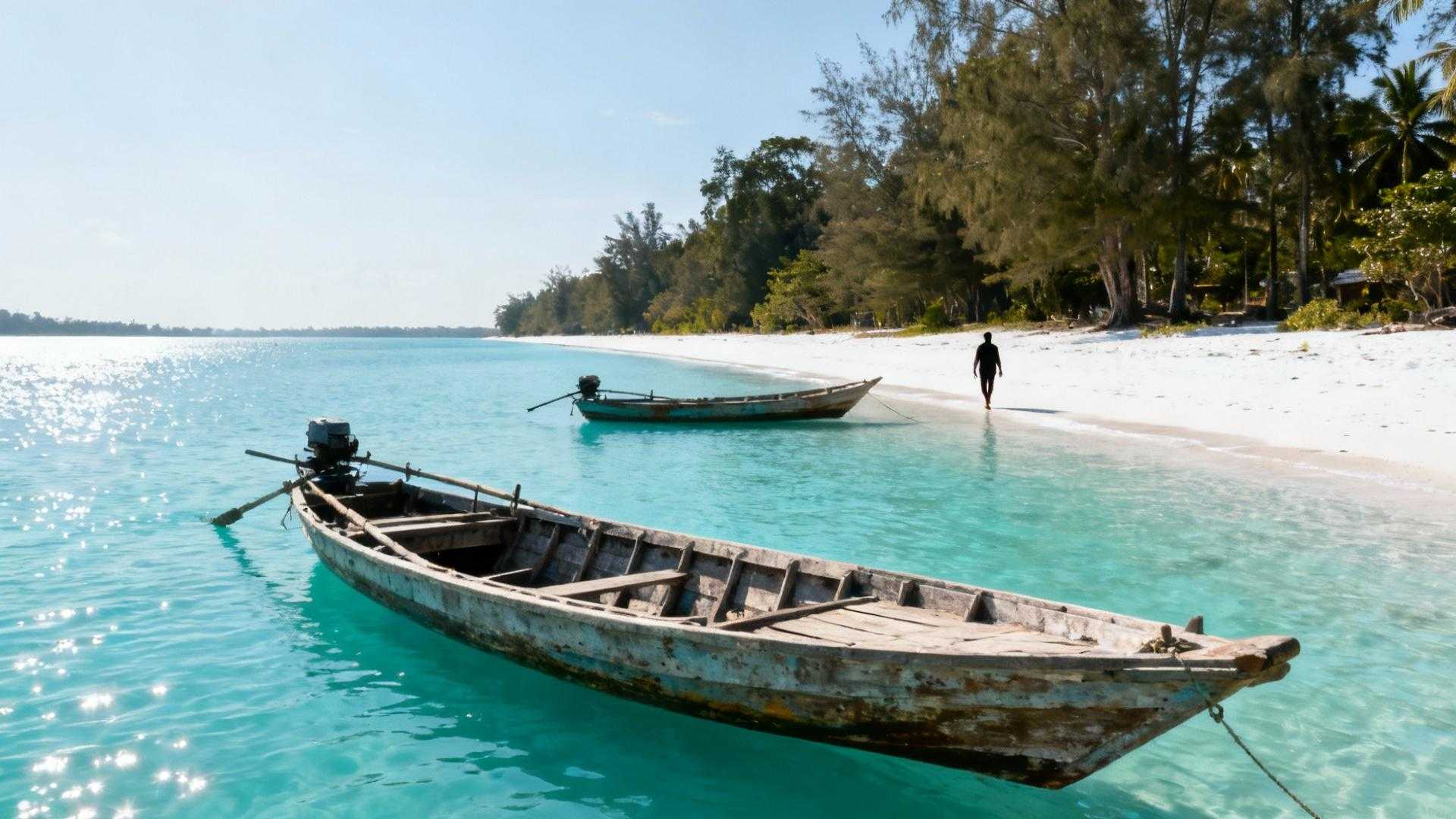After exploring more than 900 Southeast Asian islands over two decades, I can confirm that Koh Rong stands apart as Cambodia’s most authentic fishing paradise. This 78-square-kilometer jewel in the Gulf of Thailand delivers something extraordinary that Thailand’s crowded beaches lost years ago: bioluminescent plankton that transforms midnight waters into liquid starlight, mangrove sanctuaries sheltering 1,300 marine species, and traditional Khmer fishing villages where 2,500 residents still protect their ancestral waters from resort developers.
Most travelers rush past Cambodia toward Thailand’s Phi Phi Islands or Malaysia’s Perhentians. They’re missing the region’s last unspoiled tropical sanctuary, where community-run ecotourism replaces corporate resorts and $30 daily budgets deliver experiences costing $150 in neighboring countries.
The island operates under careful protection within Koh Rong Marine National Park, established in 2018. But local communities increasingly worry that their 99-year land concession may prioritize development over preservation. Visit now, before this fishing paradise transforms into another overcrowded beach resort.
The bioluminescent phenomenon that happens nowhere else in Cambodia
When darkness reveals nature’s most magical light show
Koh Rong’s bioluminescent plankton creates Southeast Asia’s most accessible natural light show. Unlike Puerto Rico’s remote Vieques Bay with its 700,000 glowing organisms per gallon, Cambodia’s version appears year-round along Koh Rong’s 43 kilometers of beaches. Every stroke through midnight waters ignites blue-green sparkles that trail your hands like underwater fireworks, most vivid during new moon phases in November, December, and January.
The science behind liquid starlight in the Gulf of Thailand
Dinoflagellates—microscopic plankton containing luciferin proteins—concentrate in Koh Rong’s warm, nutrient-rich waters. Physical disturbance triggers their defensive glow, creating trails of light visible from shore. Local guides lead $10 night kayak tours through mangrove channels where plankton density peaks, though simply wading into calm bays after dark reveals this natural phenomenon without any cost.
Why 2,500 fishing families protect these waters from tourism development
Traditional villages facing modern preservation challenges
Four traditional communities—Koh Tuich, Doeum D’keuw, Prek Svay, and Sok San—maintain fishing practices passed through six generations. These families operate community ecotourism instead of surrendering to resort developers: $2 mangrove sanctuary entry fees and $10 kayak rentals support local families while protecting marine ecosystems. Similar to Con Dao’s protected Vietnamese sanctuary where 6,000 residents guard their marine heritage, Koh Rong’s fishing communities balance tourism income with environmental preservation.
The 99-year land concession creating local anxiety
The Royal Group’s development plans promise “Asia’s first environmentally planned resort island,” but residents fear losing traditional livelihoods. NGOs document concerns about pollution, coral damage, and fishing restrictions. This tension creates urgency: experience authentic Khmer coastal culture before corporate resorts replace family-run guesthouses charging $20-50 nightly versus Thailand’s $150-300 beach resort rates.
The mangrove sanctuaries and coral reefs tourists overlook
Kayaking through Cambodia’s richest marine biodiversity
Koh Rong Marine National Park protects extensive mangrove systems accessible only by kayak or jungle trek. These nurseries shelter 1,300 marine species, from juvenile reef fish to endangered seahorses. Community guides lead three-hour tours ($10-15) through channels where kingfishers hunt and monitor lizards sunbathe, sharing traditional fishing knowledge while explaining conservation efforts.
Pristine coral reefs rivaling Thailand’s best diving spots
Lonely Beach and nearby Pineapple Island offer Cambodia’s finest snorkeling and diving, with hard corals, sea turtles, and reef sharks thriving in protected zones. Unlike Thailand’s damaged reefs suffering from overtourism, Koh Rong’s underwater ecosystems remain 70% healthier due to limited visitor numbers and strict marine park regulations. Daily snorkel trips cost $25-35 including equipment and lunch, versus $60-100 at comparable Thai islands.
Planning your visit before November’s dry season crowds arrive
The optimal booking window closing fast
October represents the perfect planning moment for November-March dry season travel. Book now and save 30% compared to December-January peak rates, when Sihanoukville ferries run hourly ($10-15, 30-45 minutes) versus limited monsoon season schedules. Similar to Thailand’s Bamboo Island offering Maya Bay’s beauty without crowds, Koh Rong delivers pristine beaches at half the cost.
Getting there and staying respectfully
International travelers connect through Phnom Penh or Sihanoukville airports via Bangkok, Singapore, or Ho Chi Minh City. Cambodia’s e-visa takes 48 hours and costs $36 for most nationalities. On-island, support community-run guesthouses rather than resort chains, respect Buddhist customs in fishing villages, and follow marine park rules protecting coral reefs. Traditional basket boats still operate in M’Pai Bay—photograph respectfully after asking permission.
Essential questions about Cambodia’s island paradise
When does bioluminescent plankton glow brightest on Koh Rong?
Peak bioluminescence occurs during dry season new moon phases (November through March), when darkness intensifies the glow and calm seas concentrate plankton. October-April offers consistent visibility, though monsoon rains (May-September) reduce plankton density and create rough conditions limiting night swimming.
How does Koh Rong compare to Thailand’s southern islands?
Koh Rong delivers similar turquoise waters, white sand beaches, and coral reefs as Phi Phi or Ko Samui, but with 70% fewer tourists and 50% lower costs. Thailand offers more developed infrastructure and dining variety, while Cambodia provides authentic fishing culture, year-round bioluminescence, and protected marine ecosystems less damaged by overtourism.
Are local communities truly concerned about overdevelopment?
Yes, documented by multiple NGOs and community organizations. The 99-year Royal Group land concession and increasing tourist numbers create genuine preservation concerns among fishing families dependent on healthy marine ecosystems. Supporting community ecotourism over corporate resorts helps sustain traditional livelihoods while protecting Koh Rong’s natural heritage.
